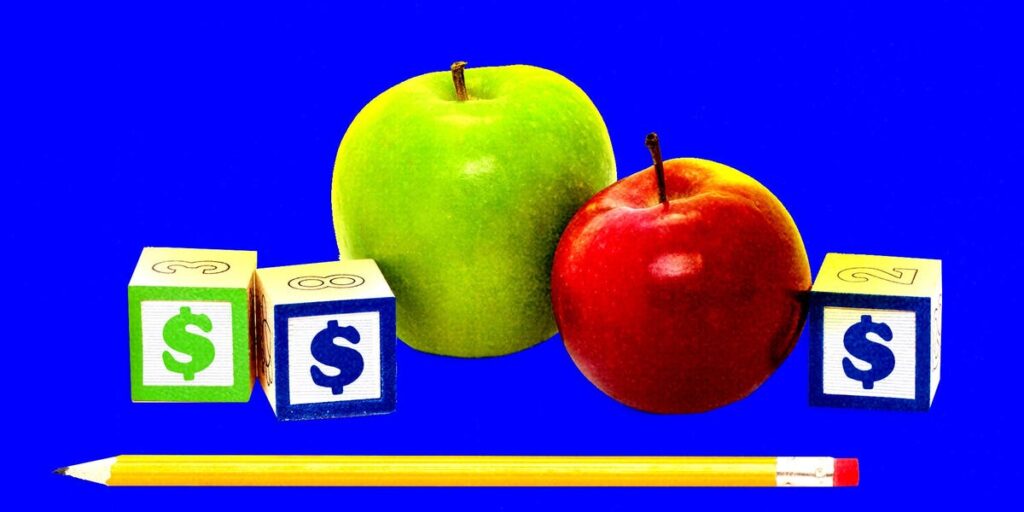Maegan Driver welcomed her kindergarten students with jellyfish dangling in her classroom and alphabet letters with underwater scenes that spell out “nice to sea you” next to sea creature cutouts on her door.
She bought the items for her ocean-themed classroom with her own money. Driver said she buys items out of pocket because she wants the students to have a better educational experience and be excited to return each day.
Many teachers like Driver spend their own money on their classrooms. A survey of 2,000 elementary school teachers from the Carnation Breakfast Essentials brand conducted by Talker Research in June found that 1 in 5 teachers said they spend over $300 out of pocket on classroom items.
“I don’t like doing it out of my own pocket because I also have children that I also have to buy their school supplies and do things for them,” Driver, who works at Trinity Christian Academy in Oklahoma, said. “But at the same time, I want my kids in my classroom to be able to have a fun learning experience, and I want them to love school.”
Rebecca Johnson, a seventh-grade teacher in Ohio, also bought decorations and supplies for her students. She spent hundreds of dollars this summer for her Horizon Science Academy Columbus Middle School classroom, including on “Peanuts” posters, clipboards, and containers to store headphones.
“I think the school gives us everything we need to teach successfully, and they give some of what we want,” Johnson said, adding she and her fellow teachers were given $100 each for supplies, as well as getting other financial support when needed.
But she wanted to go above and beyond for her students. She said it was her choice to add the additional decorations.
Spending on the classroom amid higher prices
While teachers can deduct qualified expenses on their taxes, spending hundreds of their own money for their classrooms could make a dent in their wallets.
“They, like all of us, are living in a world where the cost of grocery items and all that, household items and gasoline and all of these things are more expensive,” Steve Majors, the executive vice president and chief external affairs officer for Teach For America, told Business Insider.
Since Driver works at a private school, classroom funding can be limited since it comes from student tuition.
“I think my school is doing the best they can with what they have to help us with our classroom supplies,” Driver said. “It would be nice if they could do more, but that always depends on the number of students we have enrolled.”
It’s not just private and charter school educators who spend their money. Survey data from previous years show teachers in “traditional” public schools have to spend out of pocket.
Yelena Khazan, a first-grade teacher at a public school in Florida serving some low-income families, is excited about what’s to come during her first year as a full-time teacher.
She organized a GoFundMe fundraiser to help buy items for her classroom. $845 of her $2,000 goal had been raised. Khazan said she spent some of her own savings on top of the money from the fundraiser. Documentation shared with Business Insider showed she had spent well over $2,000 for supplies and decorations on Amazon and through other sites. She also bought items at local stores.
Khazan said in addition to students bringing in items on their school supply lists, some parents have offered even more support.
She spent money on things for her classroom because she wanted to provide her students with what they would need to be successful and because she wanted to create a comfortable environment, given how much time she and her students would be in the classroom.
“I want them to feel like they can express themselves, they feel emotionally safe, and I want it to be a welcoming environment,” Khazan said.
Majors said that schools in lower-income communities “often are under-resourced” and “their families may not have the means for all the tools that they might need in the classroom.”
Majors said people who want to support teachers, even if they don’t have school-aged children, could see if their school district has a donation fund or if they could drop off school supplies.
What the three teachers bought for their classroom goals and needs
Driver said no one wants to go into a boring classroom, and she bought most of the items in her room. She spent over $800 on Amazon purchases alone this summer for her classroom and school sports she coaches for.
“I typically have to buy things that sometimes the kids just don’t have,” Driver said.
She said the school helps with archery supplies, one of the sports she coaches, but she bought some items for flag football and basketball. For instance, she bought basketball goggles, a basketball rack, and flag football belts.
Some items Driver bought this summer include paint brushes, dot markers, a rug, and musical instruments. She said she also bought a poster that her students can press to learn about the sounds of the alphabet.
“I’m trying to keep them away from the iPads, but I still want them to be able to learn because all of them are so used to that instant gratification that I was looking for something else to be able to give them that besides an iPad or a tablet,” Driver said.
Khazan bought books, magnetic tiles, storage and organizational items, and worksheets, among other things. Flexible seating items were also a priority.
At the time of the interview, Khazan expected arts and crafts, STEM materials, and printing fees to be the main expenses for the classroom moving forward.
Johnson thinks students will be interested in learning and be more likely to take care of her items the more “aesthetically pleasing” her classroom is. She has posters hung up, lamps, and different seating for students to use in addition to standard classroom chairs.
“I treat that classroom like an extension of myself, and I want it to be aesthetically pleasing,” Johnson said. “I want it to be pretty and fun and dynamic looking.”
Johnson said she typically buys stuff for the classroom throughout the summer. However, her summer spending this year differed from the past.
“This year, I had applied for one of the assistant principal jobs, and so I kind of held off, and I didn’t buy anything, and I didn’t prep anything because if I got that job, then I was not going to decorate a classroom, so I didn’t want to waste any money,” Johnson said.
Johnson said she didn’t have to buy some things in her room, like the desks, a bookshelf, and her cart of Chromebooks. “Their financial support has to go for those kinds of things; it has to go for the electronics, the internet, the basics of what I need to teach,” Johnson said about the school.
In addition to the bulletin board provided, Johnson said she creates three more boards “by stapling the paper and the border to the wall. So it looks really colorful and it looks inviting.”
“A lot of the teachers will walk by and say to me, ‘Mrs. Johnson, if I could be a student in your classroom, I don’t think I would ever leave,'” she said. “I love that feeling.”
If you are an educator, email this reporter at mhoff@businessinsider.com to share how much you spent out of pocket for your classroom.
Read the full article here
















